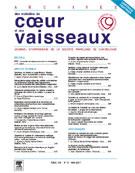04-40 - IMPROVEMENT OF LEFT VENTRICULAR DEFORMATION AFTER CATHETER ABLATION FOR ISOLATED PAROXYSMAL ATRIAL FIBRILLATION IN PATIENTS WITH NORMAL EJECTION FRACTION: A 2D STRAIN STUDY - 09/04/08
Patricia Reant,
Stephane Lafitte,
Pierre Jaïs,
Frederic Sacher,
Nicolas Derval,
Antoine Deplagne,
Stephanie Brette,
Meleze Hocini,
Pierre Bordachar,
Jacques Clementy,
Michel Haissaguerre,
Raymond Roudaut
Voir les affiliationsBackground: Paroxysmal isolated atrial fibrillation (AF) is generally associated with normal left ventricular (LV) ejection fraction. Recently, echocardiographs have been implemented by 2-dimensional (2D) strain technique, a new tool based on speckle tracking which allows accurate evaluation of the three components of LV deformation (circumferential, radial and longitudinal strains).
Objective: The aim of this prospective study was (1) to evaluate whether 2D strain evaluation could point out alteration of LV deformation in patients with paroxysmal AF and normal ejection fraction in comparison with controls; (2) to evaluate the evolution of the different strain components after AF catheter ablation.
Methods: Patients with isolated paroxysmal AF were investigated with a VIVID7 (General Electric) before ablation, at 1 month (M1) and at 6 months (M6) after catheter ablation.
Results: Twenty five successive patients (mean 58 ± 12 years, 5 women) with isolated paroxysmal AF (mean since 8 years) and 25 controls were investigated. Before ablation, no significant difference was observed in term of LV ejection fraction between the 2 groups (p ns). In patients with paroxysmal AF, global longitudinal strain (GLS) and global circumferential strain (GCS) were significantly reduced compared to controls: GLS was -17.8 ± 2.9% vs -21.4 ± 2% in controls (p < 0.001) and GCS was -15.4 ± 4.1% vs -21.1 ± 2.8% in controls (p < 0.001). In contrast, no significant difference was observed for the global radial strain (GRS). After ablation, GLS increased from -17.8 ± 2.9% to -19.3 ± 2.3% (M1) (p < 0.05), and to -19.3 ± 2% (M6) (p = 0.07), and GCS increased from -15.4 ± 4.1% to -15.7 ± 2% (M1) (p ns), and -16.3 ± 1.7% (M6) (p ns). GRS was not significantly modified (from 41.7 ± 17% to 37.1 ± 12.4% (M1) (p ns) and 44.3 ± 14% (M6) (p ns)).
Conclusions: Paroxysmal AF induced subclinical LV dysfunction as demonstrated by the decrease in longitudinal and circumferential strains in patients with normal ejection fraction. In our patients, this LV dysfunction tends to be improved after AF catheter ablation.
Plan
© 2007 Elsevier Masson SAS. Tous droits réservés.
Vol 100 - N° 12
P. 1081-1082 - décembre 2007 Retour au numéroBienvenue sur EM-consulte, la référence des professionnels de santé.

